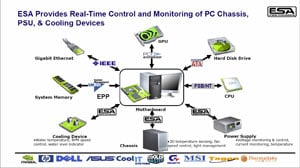NVIDIA nForce 790i SLI Ultra and GeForce 9800 GX2
Feature Spotlight: ESA

 As it stands today, many of the major components in a typical enthusiast class PC have built-in mechanisms for monitoring the health of the device. Processors and GPUs have internal thermal diodes for monitoring temperatures, and graphics cards and motherboards have sensors for monitoring a myriad of voltages, temperatures, and things like fan speeds. Other components, however, like cases, power supplies, and cooling systems, for example, usually don’t have any such mechanism. And even if they do, odds are it uses a proprietary interface that isn’t universally compatible.
As it stands today, many of the major components in a typical enthusiast class PC have built-in mechanisms for monitoring the health of the device. Processors and GPUs have internal thermal diodes for monitoring temperatures, and graphics cards and motherboards have sensors for monitoring a myriad of voltages, temperatures, and things like fan speeds. Other components, however, like cases, power supplies, and cooling systems, for example, usually don’t have any such mechanism. And even if they do, odds are it uses a proprietary interface that isn’t universally compatible.
To remedy this situation, the crew at NVIDIA architected a new open standard that has been gaining traction across the industry. ESA, or the Enthusiast System Architecture, as it is known, was designed for real-time monitoring and control of PC power supplies, chassis and water cooling systems.
The ESA standard is built around the USB HID (Human Interface Device) specification and has recently been approved by the USB-if HID subcommittee. ESA is essentially a hardware and software based interface that takes data collected by analog sensors and converts it to digital information that can accessed via software. Below are a handful of slides that explain some of the inner workings of ESA.
|
|
|
If you take a look at the slides above, they'll give you an idea as to what NVIDIA is doing with ESA. As you'll see, ESA compliant hardware features an embedded microcontroller and will connect to a system via a standard USB cable. Currently, NVIDIA has developed new software as an extension of their nTune system utility for use with ESA, but partners that build ESA compliant hardware can also incorporate the data into their own proprietary PC health monitoring / status applications, like Gigabyte's Easy Tune or Asus' PC Probe, for example.
The question remains, how would ESA compliant hardware affect you as an enthusiast? As an example, let's consider a case. An ESA compliant case could have a number of thermal sensors throughout its interior with their positions throughout the enclosure recorded in ROM. The fans used in the case are also connected to an ESA compliant controller. Should one of the thermal sensors in the case read a high temperature, the ESA microcontroller can instruct the necessary case fans to spin up, which will reduce the temperature. Cooling devices can also gain new functionality like real-time monitoring of water temperatures and flow-rates and controlled fans and pumps. And the data collected can be viewed through software or even by glancing down at LEDs that can be programmed to change colors in different scenarios.

When ESA was first announced, NVIDIA named a number of high-profile partners the company claimed were backing the ESA standard, like Asus, Dell, CoolIT, Cooler Master, Gigabyte, MSI, Thermaltake, among others. Since that initial announcement, we've seen a number of products at events like CES that were ESA compliant. And for this launch, NVIDIA showed off another group of products that take advantage of ESA. We've got Silverstone's TJ10 ESA eidtion case pictured above, as well as Thermaltake's Big Water 780e liquid-cooling system, and a Top Power PSU too. Although it wasn't clear that ESA would take off when the standard was unveiled, it appears now that more and more manufacturers are jumping on board.









